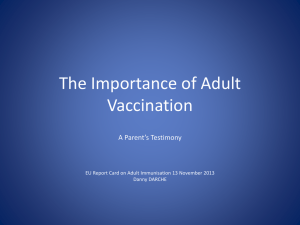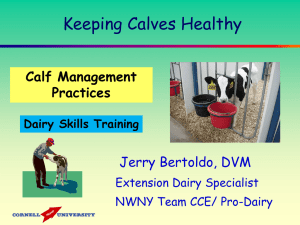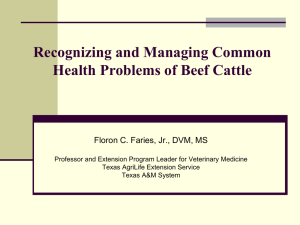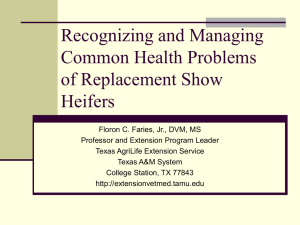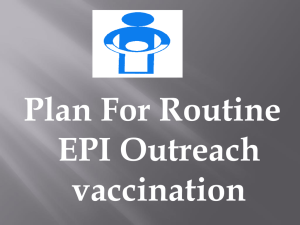Report of the Veal Calf Vaccination Study with Bovilis Bovipast
advertisement
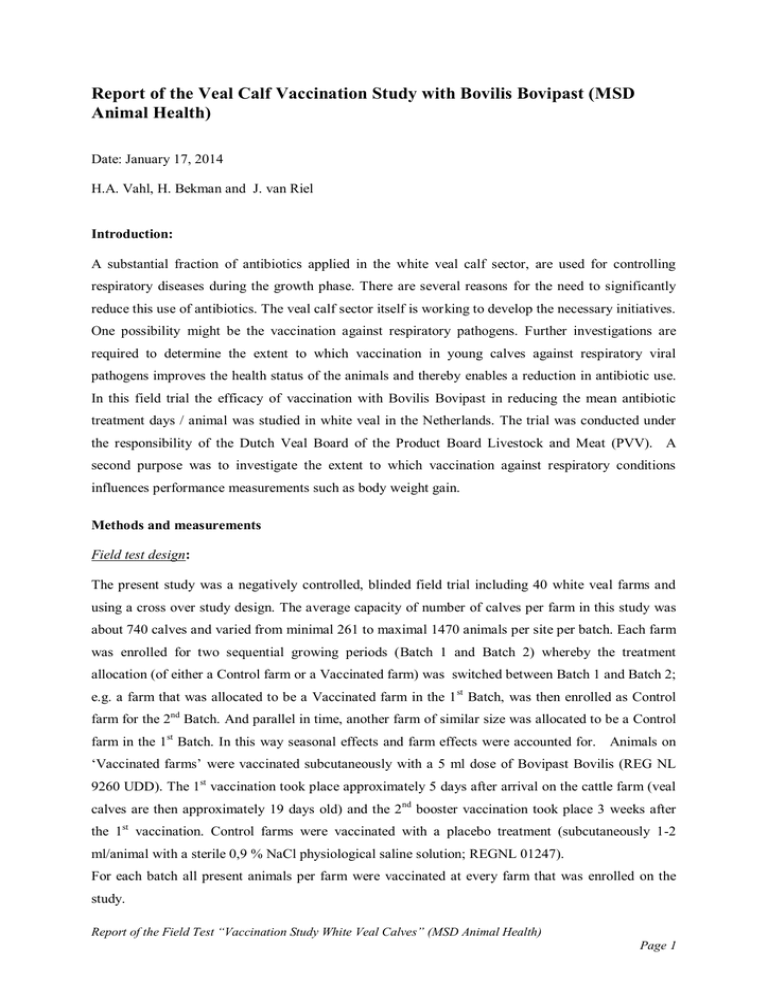
Report of the Veal Calf Vaccination Study with Bovilis Bovipast (MSD Animal Health) Date: January 17, 2014 H.A. Vahl, H. Bekman and J. van Riel Introduction: A substantial fraction of antibiotics applied in the white veal calf sector, are used for controlling respiratory diseases during the growth phase. There are several reasons for the need to significantly reduce this use of antibiotics. The veal calf sector itself is working to develop the necessary initiatives. One possibility might be the vaccination against respiratory pathogens. Further investigations are required to determine the extent to which vaccination in young calves against respiratory viral pathogens improves the health status of the animals and thereby enables a reduction in antibiotic use. In this field trial the efficacy of vaccination with Bovilis Bovipast in reducing the mean antibiotic treatment days / animal was studied in white veal in the Netherlands. The trial was conducted under the responsibility of the Dutch Veal Board of the Product Board Livestock and Meat (PVV). A second purpose was to investigate the extent to which vaccination against respiratory conditions influences performance measurements such as body weight gain. Methods and measurements Field test design: The present study was a negatively controlled, blinded field trial including 40 white veal farms and using a cross over study design. The average capacity of number of calves per farm in this study was about 740 calves and varied from minimal 261 to maximal 1470 animals per site per batch. Each farm was enrolled for two sequential growing periods (Batch 1 and Batch 2) whereby the treatment allocation (of either a Control farm or a Vaccinated farm) was switched between Batch 1 and Batch 2; e.g. a farm that was allocated to be a Vaccinated farm in the 1 st Batch, was then enrolled as Control farm for the 2nd Batch. And parallel in time, another farm of similar size was allocated to be a Control farm in the 1st Batch. In this way seasonal effects and farm effects were accounted for. Animals on ‘Vaccinated farms’ were vaccinated subcutaneously with a 5 ml dose of Bovipast Bovilis (REG NL 9260 UDD). The 1st vaccination took place approximately 5 days after arrival on the cattle farm (veal calves are then approximately 19 days old) and the 2nd booster vaccination took place 3 weeks after the 1st vaccination. Control farms were vaccinated with a placebo treatment (subcutaneously 1-2 ml/animal with a sterile 0,9 % NaCl physiological saline solution; REGNL 01247). For each batch all present animals per farm were vaccinated at every farm that was enrolled on the study. Report of the Field Test “Vaccination Study White Veal Calves” (MSD Animal Health) Page 1 Animals and housing The test animals were veal calves (> 80 % males, Holstein-Frisian and originating from The Netherlands or Germany) as delivered to the farms. Age at arrival to the farm was at least 2 weeks. The mean fattening period was 183 days for Batch 1 and 190 days for batch 2. For the first four to six weeks animals were housed individually with open fences (so called baby boxes) and group housed thereafter, in groups of 5 - 6 calves on most farms, in some instances in groups of up to 10 calves per group. The calves were milkfed with commercial milk replacer from respective Integrators twice daily from the day of arrival throughout the growing period. From about 2 weeks after arrival a mixture of roughage and concentrate was fed. The composition of the mixture was mostly concentrate with maize silage and/or wheat straw. The daily quantity of the mixture was restricted in the start to semiad libitum during the finishing period. Regular health checks were performed at least twice daily by the farmer at every enrolled farm. Enrolment Criteria: Farms: The farms were selected from one of the four Dutch Veal integrations (Van Drie, Denkavit, former Alpuro and Pali-group). All participating farms were classed as ‘white veal’ growers. Every participating farm did fulfil the following enrolment criteria: per site > 80 % male and all calves were slaughtered in Dutch slaughterhouses. All participating farms did work based on the all-animals-in – all-animals-out principle. Animal intake was as much as possible completed within a maximum period of 5 days. Animals: Only healthy flocks were enrolled on the study and only healthy calves were vaccinated. Exclusion Criteria Farms that did not fulfil the above mentioned criteria concerning (> 80 % male, all in/all-out, animals slaughtered in The Netherlands) were excluded from the data set. Method of vaccination Vaccine: As vaccine Bovilis Bovipast (MSD Animal Health) was used. Bovilis Bovipast (REG NL 9260 UDD) is a combination vaccine administered subcutaneously in a 5 ml dose containing inactivated Bovine Report of the Field Test “Vaccination Study White Veal Calves” (MSD Animal Health) Page 2 Respiratory Syncytial virus (RS virus), inactivated Parainfluenza type 3 (PI3) virus and inactivated Mannheimia haemolytica A1. Storage of the test article was executed by the veterinary practice of the practitioner. The 1st vaccination took place approximately 5 days after arrival on the cattle farm (veal calves are then approximately 19 days old) and the 2nd booster vaccination took place approximately three weeks after the 1st vaccination. Each vaccination was recorded and documented by the vaccination team and indicate how many and which animals have been vaccinated, and the date of the administration. The vaccinations were done by a vaccination team consisting of vaccinating veterinarian, assisted by one or two paraveterinarians. Only healthy animals (no signs of respiratory disease or other signs of critical illness) were vaccinated. Any calves not suitable for vaccination on day 5 were as much as possible vaccinated within a period of one week thereafter. Any delayed vaccination was recorded. Procedure for veterinarians and antibiotic treatment: In case of any animal with signs of respiratory disease or with any other signs requiring veterinary attention this was recorded. Any treatments given, dose and duration of treatment and diagnosis or suspect diagnosis were recorded (by the veterinarian or farmer) on local site records according to site practice. In case of respiratory disease antibiotic treatments were administered as much as possible on an individual animal basis up to a disease incidence level of 10% within 5 days. Also if during a 24 hour period the increase of diseased animals in the herd is ≥ 4 %, blanket group treatment was permitted. Randomisation and Blinding: This trial was blinded, and participating farmers and veterinary practitioners were not aware of the allocation of farm to treatment. None of the Veterinarians who make disease assessments on any participating farm and make treatment decisions, or involved farmers did know the treatment allocation to the farms, or were present during the test article administration procedure. The treatment allocation plan was only available to the statistician and the Vaccination team. The random treatment allocation plan was produced by the statistician. It was intended that as much as possible a block of two farms had the same veterinary practitioner. All farms and growing batches were identified by a unique number. The vaccinating veterinarian selected the treatments of the farms and batches via a lottery list received from the statistician. Data collection antibiotic use Report of the Field Test “Vaccination Study White Veal Calves” (MSD Animal Health) Page 3 The data from this study were collected from the participating integrators. To promote that data from all four integrators are calculated in a comparable way, each data set were checked by LEI concerning their validity. The calculations concerning the use of antibiotic and other medicines is based on the methods as mentioned in the publication of LEI (2012, “Trends in veterinary antibiotic use in the Netherlands 2004-2012, LEI 12-109 “). In summary the number of daily dosages per animal was determined by calculating the total number of kilograms of animal (at the respective time of treatment) that can be treated with each active ingredient: the treatable weight. This were then be divided by the total weight of the number of veal calves on the farm. Table 1 shows in more detail how the below mentioned data were defined and which calculations are done. Performance parameters For each growing period from every farm enrolled (= one experimental unit) the following data were collected or calculated: a. b. c. d. e. f. g. h. Days of fattening period (days) Mean cold carcass weight per animal mean live body weight at slaughter per animal (slaughter weight / 0.63) Mean input body weight Mean (estimated) body weight gain (kg/day) Mortality rates (%) (difference between number of animals at arrival versus at slaughter) Rate of poor growers (%) Mean number of daily antibiotic dosages for the following periods: g.1 0 – 190 days g.2 0 – 84 days g.3 14 – 84 days g.4 14 – 190 days i. Mean number of daily individual antibiotic dosages (all treatments) j. Mean number of daily individual antibiotic dosages for respiratory disease k. Mean number of daily individual corticosteroid dosages l. Mean number of daily individual NSAID’s dosages m. Mean number of daily individual bromohexine dosages Table 1 Definitions used for the calculations Description Date of start Date of slaughter Cold carcass weight (kg) Starter body weight (kg) Definition mentioned as one starting day (if more than 1 day started then a weighted average) mentioned as one slaughtering day (if more than 1 day slaughtered then a weighted average) The cold carcass weight was determined after a slaughtering process regulated by Dutch Veal Board-standards. The calves were slaughtered in The Netherlands. The mean live body weight of the calves at arrival. This can be weighted or estimated, based on age and condition. If more than one day arrival than a weighted average is Report of the Field Test “Vaccination Study White Veal Calves” (MSD Animal Health) Page 4 Days of fattening period calculated. total days of fattening period between start and final of the fattening period (approximately 196 days) mortality (% / herd) percentage of died animals per herd based of total animals at start minus total number of animals at slaughtering Live body weight of slaughtered animals The cold carcass weight divided by 0.63 (kg/animal) body weight gain ( g / day) % poor-do-ers in the herd Mean kg of growth ( = live weight of slaughtered calf minus the group mean body weight at arrival) of the slaughtered animal divided by total fattening days (grams/day/herd) number of slaughtered calves with a body weight at slaughter ≤ 85 % of mean carcass weight of the herd divided by the total number of slaughtered calves of the herd Quantity of used antibiotics Quantity of delivered antibiotics per herd minus retour antibiotics per herd (grams per herd) live body weight during the treatment mean body weight of herd based on current date of fattening during medical flock treatment (kg) antibiotic daily dosages the number of daily dosages per fattening animal was determined by calculating the total number of kilograms of animal that can be treated with each active ingredient: the treatable weight. This was then divided by the total weight of the number of veal calves on the farm, based on the estimated body weight at the current date of treatment. the number of total individual treated daily dosages per fattening animal was determined by calculating the total number of kilograms of animal that can be treated with the total quantity of antibacterial active ingredient used as individual treatment: the treatable weight. This was then divided by the total weight of the number of veal calves on the farm, based on the estimated body weight at the current date of treatment. the number of total individual treated daily dosages per fattening animal for respiratory diseases was determined by calculating the total number of kilograms of animal that can be treated with the total quantity of antibacterial active ingredient used as individual treatment for respiratory disease: the treatable weight. This was then divided by the total weight of the number of veal calves on the farm, based on the estimated body weight at the current date of treatment. the number of daily dosages per fattening animal was determined by calculating the total number of kilograms of animal that can be treated with each active ingredient: the treatable weight. This was then divided by the total weight of the number of veal calves on the farm, based on the estimated body weight at the current date of treatment. the number of daily dosages per fattening animal was determined by calculating the total number of kilograms of animal that can be treated with each active ingredient: the treatable weight. This was then divided by the total weight of the number of veal calves on the farm, based on the estimated body weight at the current date of treatment. the number of daily dosages per fattening animal was determined by calculating the total number of kilograms of animal that can be treated with each active ingredient: the treatable weight. This was then divided by the total weight of the number of veal calves on the farm, based on the estimated body weight at the current date of treatment. total individual treated antibiotic daily dosages total individual treated antibiotic daily dosages for respiratory diseases Corticosteroids daily dosages NSAID’s daily dosages Bromohexine daily dosages Statistical methods & data analysis: Report of the Field Test “Vaccination Study White Veal Calves” (MSD Animal Health) Page 5 The Statistical analysis were two-sided, using a 5% significance level (P 0.05). The farm-period combination was the experimental unit. Individual cold carcass weight, group body weight gain, group number of daily antibiotic dosages (for five different time periods), mortality rate and rate of poor growers were analysed with a mixed model with the fixed effect of treatment and random effects: block, period, farm within block, period by block and period by farm within block (which is the residual term). Cold carcass weight and body weight gain (= calculated) are considered as normal distributed. The number of daily antibiotic dosage was log transformed prior to analysis. Least squares means and standard errors (both cold carcass weight and calculated group body weight gain on the original scale; the other on the transformed scale) were calculated for each treatment. The statistical analysis was performed using the Genstat program. Blinding To check the blindness of this field trial we sent after the vaccinations in the second batch a questionnaire wherein we asked the farmers if they had an idea in which batch the placebo and in which batch the real vaccination was executed. Results The field trial had a good course. The first flock started in Dec. 2010 and the last flock was slaughtered at the end of 2012. From the 80 vaccinated flocks one flock was excluded because the first vaccination was performed too late and a second flock was excluded because the type of calves did not fulfil the inclusion criteria. In table 2 the results of the treatment on antibiotic, other medicines and some technical performances are summarized. Report of the Field Test “Vaccination Study White Veal Calves” (MSD Animal Health) Page 6 Table 2 Effects of vaccination on the daily dosages of antibiotic and other medicines and some technical performances Control Bovilis Bovipast p-value Batch 1 Batch 2 p-value Antibiotic (1): Total (0 - 190 d) 35.3 30.2 0.024 35.9 29.6 0.019 0 - 84 d 31.7 26.9 0.016 32.8 26.0 0.005 14 – 84 d 13.9 11.1 0,028 13.3 11,6 0.140 14 – 190 d 17.3 14.3 0.055 16.3 15.3 0.510 (2) Total (individual) 2.9 2.3 0.065 2.6 2.6 0.880 Total (individual, 2.8 2.3 0.147 2.6 2.4 0.667 (2) respiratory disease) Other medicines: (total period) Corticosteroids 0.2 0.1 0.338 0.1 0.2 0.286 NSAID’s 0.7 0.6 0.380 0.6 0.7 0.746 Bromohexine 5.2 1.8 0.003 2.5 3.7 0.333 Technical performances: Growth (relative %) 100 99.1 n.s (3) 100 103.0 sign.(3) Mortality (relative %) 100 96.1 n.s 100 95.4 n.s Poor do-ers (relative 100 98.0 n.s 100 102.0 n.s %) (1) : By using log transformation before analyses of daily antibiotic dosages the antibiotic dosages for the different periods cannot be added and subtracted (2) : Total (Individua)l are all antibiotics applied non orally, whereas total (individual for respiratory disease) are only antibiotics applied non orally used at that time for respiratory diseases (3): sign. and n.s. means significant, respectively not significant Vaccination with Bovipast had a significant reducing effect on daily dosages of antibiotic. The total daily dosages during the entire fattening period decreased from 35.3 to 30.2 days which means a reduction of 14.5 %. This reduction is mainly in the period 0-84 days (31.7 versus 26.9). When comparing the antibiotic use in the period between 14 and 84 days, the reduction was 20%. There was a trend that also the total individually dosed antibiotics were reduced (2.9 versus 2.3 days). Moreover, after vaccination with Bovipast the use of Bromohexine was also significantly reduced. There was no difference between the vaccinated and control with regards to the technical performance parameters. Independent of the vaccine effect in the second batch significant lower antibiotics were used, both in the total period and in the period from 0 – 84 days. Besides, in the second batch the body weight gain was higher than in the first batch. Report of the Field Test “Vaccination Study White Veal Calves” (MSD Animal Health) Page 7 Blinding From the 40 farms we received from 31 an useful investigation form. Based on the 31 investigation forms sixteen farmers mentioned the correct batch wherein the placebo and vaccination was executed. From this sixteen correct answers ten farmers mentioned that their suggestion was based on signs and vaccination reaction from the flock within some days after the vaccination (mostly “quiet” animals, and some respiratory reaction). In two cases the execution of the vaccination was mentioned. From the fifteen other returned forms eight farmers indicated that they had no idea which vaccination was the placebo. Three farmers mentioned vaccination reactions after the placebo. Discussion In this field trial, significantly fewer antibiotics were used in the farms that had been vaccinated with Bovilis Bovipast. Therefore, vaccination can be an useful tool to reduce antibiotic use on farms. Also the use of bromohexine was clearly reduced during the batches with vaccination. We have to underline that in this report the number of daily antibiotic dosages was log transformed prior to analysis. This means that our calculated daily dosages are not comparable with the method of the current measurement of daily dosages in practice. The fact that the use of antibiotics was reduced in the second batch is the effect of a changing attitude of veterinarians and farmers to be more restrictive in the use of use of antibiotics and in line with the national development in reduction of the use of antibiotics in the veal sector. In this study, the performance parameters were not different between vaccinated and control batches. A number of factors might have contributed to this result e.g. i) the use of antibiotics limited the effect of respiratory disease on the growth of the affected animals, ii) animals that died for other reasons than respiratory disease were included in the mortality rate. That in the second batch the body weight gain was higher than in the first batch, is probably due to the longer fattening period ( 190 versus 183 days). Because both after vaccination and after placebo reactions were mentioned we conclude that in most cases the experiment was done totally blind for the farmer. Acknowledgment: We like to thank the members of the vaccination team for their precise working attitude during the vaccinations. Besides we thank the guiding group of the Product Board for their advises during this vaccination field test. Also we thank LEI for checking the data concerning the provided medicines. Last but not least we thank MSD Animal Health for their support to perform this vaccination study in veal calves. Report of the Field Test “Vaccination Study White Veal Calves” (MSD Animal Health) Page 8
